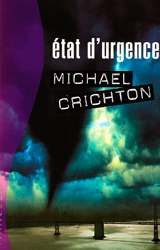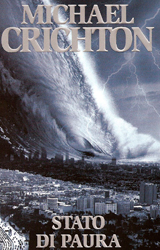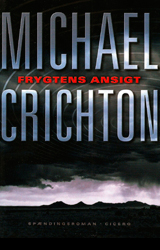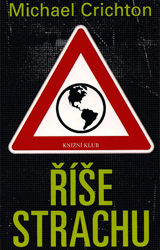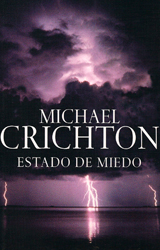State of Fear
In His Own Words
I didn’t want to write it. I decided I wouldn’t write it. I had breakfast with a friend of mine who I hadn’t seen in 30 years and I told them my dilemma and he said no, you have to write it. I said I might get killed for this. He said, no, you have to write it. I would like to be able to say that as a result of that conversation I decided to write it. I didn’t. I went home and I thought, you know, I’m not writing this. It doesn’t matter. Keep my opinion to myself. I started to work on something else and I felt like a coward and I thought what are you going to do? You have looked at the data and you really believe that it’s in effect but not something that we as human beings should be worrying about. […] It’s low on the totem pole. We ought to be taking care of disease. We ought to be taking care of world hunger. We ought to be taking care of a lot of things before we do this.


Synopsis
In Paris, a physicist dies after performing a laboratory experiment for a beautiful visitor.
In the jungles of Malaysia, a mysterious buyer purchases deadly cavitation technology, built to his specifications.
In Vancouver, a small research submarine is leased for use in the waters off New Guinea.
And in Tokyo, an intelligence agent tries to understand what it all means.
Thus begins Michael Crichton’s exciting and provocative techno-thriller State of Fear. Only Crichton’s unique ability to blend scientific fact with pulse-pounding fiction could bring such disparate elements to a heart-stopping conclusion.
This is Crichton’s most wide-ranging thriller. State of Fear takes the reader from the glaciers of Iceland to the volcanoes of Antarctica, from the Arizona desert to the deadly jungles of the Solomon Islands, from the streets of Paris to the beaches of Los Angeles. The novel races forward on a roller-coaster thrill ride, all the while keeping the brain in high gear. Gripping and thought provoking, State of Fear is Michael Crichton at his very best.
Passage 1
Christ, it was cold, George Morton thought, climbing out of the Land Cruiser. The millionaire philanthropist stamped his feet and pulled on gloves, trying to warm himself. It was three o’clock in the morning, and the sky glowed red, with streaks of yellow from the still-visible sun. A bitter wind blew across the Sprengisandur; the rugged, dark plain in the interior of Iceland. Flat gray clouds hung low over the lava that stretched away for miles. The Icelanders loved this place. Morton couldn’t see why.
In any case, they had reached their destination: directly ahead lay a huge, crumpled wall of dirt-covered snow and rock, stretching up to the mountains behind. This was Snorrajokul, one tongue of the huge Vatnajokull glacier, the largest ice cap in Europe.
The driver, a graduate student, climbed out and clapped his hands with delight. “Not bad at all! Quite warm! You are lucky, it’s a pleasant August night.” He was wearing a T-shirt, hiking shorts, and a light vest. Morton was wearing a down vest, a quilted windbreaker, and heavy pants. And he was still cold.
He looked back as the others got out of the backseat. Nicholas Drake, thin and frowning, wearing a shirt and a tie and a tweed sport coat beneath his windbreaker, winced as the cold air hit him. With his thinning hair, wire-frame glasses, and pinched, disapproving manner, Drake conveyed a scholarly quality that in fact he cultivated. He did not want to be taken for what he was, a highly successful litigator who had retired to become the director of the National Environmental Resource Fund, a major American activist group. He had held the job at NERF for the last ten years.
Next, young Peter Evans bounced out of the car. Evans was the youngest of Morton’s attorneys, and the one he liked best. Evans was twenty-eight and a junior associate of the Los Angeles firm of Hassle and Black. Now, even late at night, he remained cheerful and enthusiastic. He pulled on a Patagonia fleece and stuck his hands in his pockets, but otherwise gave no sign that the weather bothered him.
Morton had flown all of them in from Los Angeles on his Gulfstream G5 jet, arriving in Keflavik airport at nine yesterday morning. None of them had slept, but nobody was tired. Not even Morton, and he was sixty-five years old. He didn’t feel the slightest sense of fatigue.
Just cold.
Passage 2
“I brought the papers canceling your grant,” Evans said, taking them out of his briefcase. “If you still want to do this.”
“I do,” Morton scribbled his signature, hardly looking at the documents. He said “Keep those safe until tomorrow.” He looked back at his guests, who were now trading statistics on species loss as the rain forests of the world were cut down. Off to one side, Ted Bradley, the actor who played the president, was talking about how he preferred his electric car — which, he pointed out, he had owned for many years now — to the new hybrids that were so popular. “There’s no comparison,” he was saying. “The hybrids are nice, but they’re not the real thing.”
At the center table, Ann Garner, who sat on the boards of environmental organizations, was arguing that Los Angeles needed to build more public transportation, so that people could get out of their cars. Americans, she said, belched out more carbon dioxide than any other people on the planet, and it was disgraceful. Ann was the beautiful wife of a famous attorney, and always intense, especially on environmental issues. Morton sighed. He turned to Evans. “Do you know how much pollution we’re creating right this minute? We’ll burn four hundred fift gallons of aviation fuel to take twelve people to San Francisco. Just by making this trip, they’re generating more pollution per capita than most people on the planet will generate in a year.
He finished his vodka, and rattled ice in the glass irritably. He handed the glass to Evans, who dutifully signaled for more.
“If there’s anything worse that a limousine liberal,” Morton said, “it’s a Gulfstream environmentalist.”
“But George,” Evans said. “You’re a Gulfstream environmentalist.”
“I know it,” Morton said. “And I wish it bothered me more. But you know what? It doesn’t. I like flying around in my own airplane.”
Passage 3
“No wonder they’re concerned that the ice here is melting,” Evans said.
Kenner said nothing.
Sanjong was shaking his head.
Evans said, “Come on, guys. Antarctica is melting.”
“Actually, it’s not,” Sanjong said. “I can give you the references, if you’d like.”
Kenner said, “While you were asleep, Sanjong and I were talking about how to clarify things for you, since you seem to be so ill-informed.”
“Ill-informed?” Evans said, stiffening.
“I don’t know what else one would call it,” Kenner said. “Your heart may be in the right place, Peter, but you simply don’t know what you’re talking about.”
“Hey,” he said, controlling his anger. “Antarctica is melting.”
“You think repetition makes something true? The data show that one relatively small area called the Antarctic Peninsula is melting and calving huge icebergs. That’s what gets reported year after year. But the continent as a whole is getting colder, and the ice is getting thicker.”
“Antarctica is getting colder?”
Sanjong had taken out a laptop and was hooking it up to a small portable bubble jet printer. He flipped open his laptop screen.
“What we decided,” Kenner said, “is that we’re going to give you references from now on. Because it’s too boring to try to explain everything to you.”
From the Archives
States of Fear: Science or Politics? Speech
Michael Crichton discusses Chernobyl, the origins of the novel State of Fear, the language of ecological scare-tactics, the ongoing, 150-year trend toward energy decarbonization, and the concept of “information invalids”-people sickened by bad information.
The Independent Institute
November 15, 2005
Global Warming is Not a Crisis – IQ2 Debate
Motion: Global Warming is Not a Crisis
Intelligence² US audience confirms 46.22% to 42.22% in favor of the motion. Speaking for the motion: Michael Crichton, Richard S. Lindzen, Philip Stott Speaking against the motion: Brenda Ekwurzel, Gavin Schmidt, Richard C.J. Somerville Moderator: Brian Lehrer
A debate in New York City
March 14, 2007


In His Own Words
I thought, “I’m an outsider; I’m not sided; I’m a political agnostic and I think what’s valuable is that I have come to my own conclusion here.” But it was clear in the brief conversations I had with the people who were doing the modeling that where we party company is—I think what they’re doing is terrific; the climate research is, in many ways dazzling; an extraordinarily ambitious undertaking; this is a multi-generational computer modeling activity that’s being done, and it’s fabulous—it’s simply not good enough to set policy on. Whereas they, of course, think it is. That was the essential difference. But to the extent that there’s controversy about my views, I must say it’s really amazing to me because I never thought the idea that you can’t predict the future would be controversial. When I talk to audiences, I get up and say, “Can we agree that you can’t predict the future, unless you guys think you’re all psychic? But if you’re not psychic, then we really have to face some cold realities about how unpredictable the future is.” I talk to them about, for example, what a person in the year 1900 would predict for the year 2000. The big problem that a person in the year 1900 would see was: Where will they get all the horses for the year 2000 and what will we do with all the horseshit? There’s a very interesting picture floating around on the internet which is said to be from an 1954 issue of Popular Mechanics showing the Rand Corporation’s mockup of a home computer. It’s really silly and very amusing, and unfortunately it’s a fake; it’s great, but it’s a fake. I was sufficiently intrigued by this that I went back to Popular Mechanics to look at what they did actually say about the home computer. Do you know what they said? Nothing at all. Do you know why? No one thought it was possible.
There has been much controversy and misinformation about Michael Crichton’s views on the subject of Climate Change. Michael Crichton lays out his viewpoints at the end of State of Fear and you can read them here in his Author’s Message.
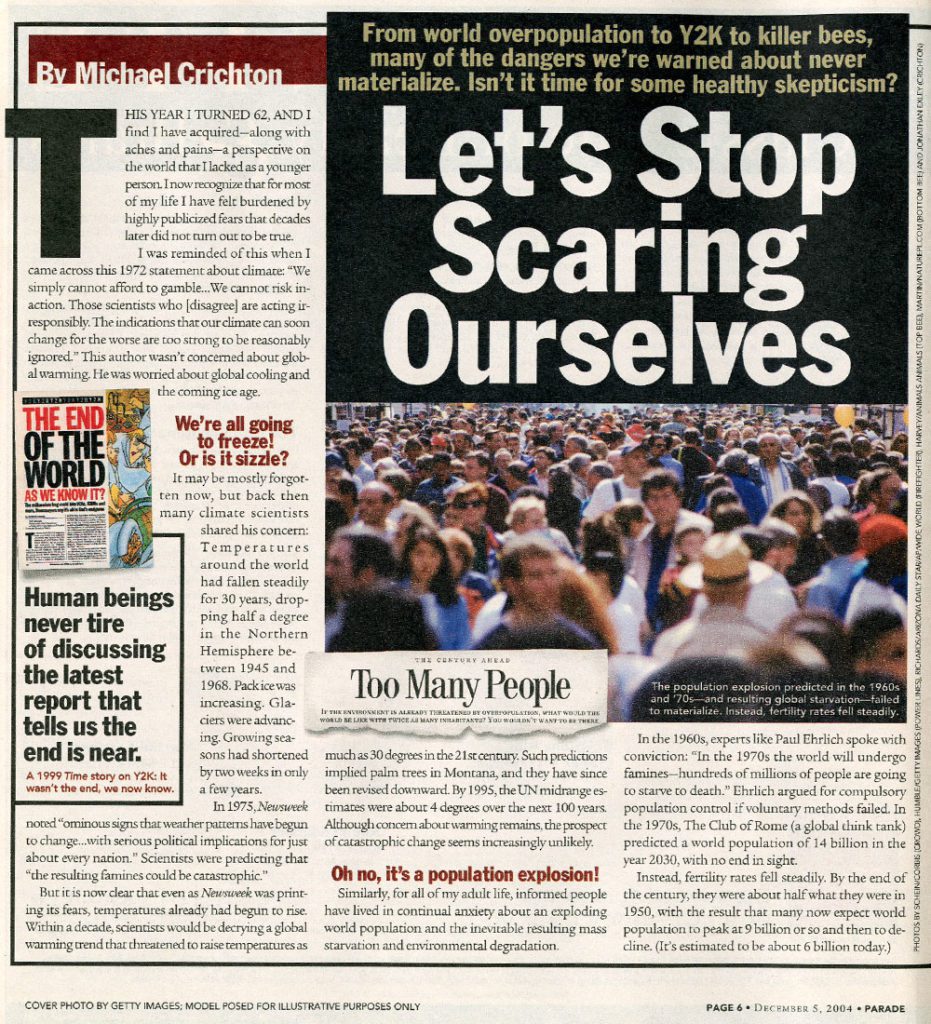

Let’s Stop Scaring Ourselves
In 2004, Michael Crichton wrote an article for Parade magazine that coincided with the release of his novel, State of Fear. In it he talks about all of the “scary things” people have worried about in his lifetime that never came to pass. He concludes the essay with this advice:
“I’ve seen a heap of trouble in my life, and most of it never came to pass,” Mark Twain is supposed to have said. At this point in my life, I can only agree. So many fears have turned out to be untrue or wildly exaggerated that I no longer get so excited about the latest one. Keeping fears in perspective leads me to ignore more of the frightening things I read and hear — or at least to take them with a pillar of salt.
For a time I wondered how it would feel to be without these fears and the frantic nagging concerns at the back of my mind. Actually, it feels just fine.
I recommend it.”
Senate Testimony
On September 28, 2005, Michael Crichton testified before the United States Senate Committee on Environment and Public Works in Washington, DC. Michael Crichton argued for independent verification of research used for public policy, and criticized the so-called “hockeystick” study, for reasons later confirmed by the Wegman Commission. Here is the beginning of his remarks:
“Thank you Mr. Chairman, and members of the Committee. I appreciate the opportunity to discuss the important subject of politicization of research. In that regard, what I would like to emphasize to the committee today is the importance of independent verification to science.
In essence, science is nothing more than a method of inquiry. The method says an assertion is valid—and merits universal acceptance—only if it can be independently verified. The impersonal rigor of the method means it is utterly apolitical. A truth in science is verifiable whether you are black or white, male or female, old or young. It’s verifiable whether you like the results of a study, or you don’t. “
You can watch Michael Crichton’s testimony on the U.S. Senate Committee on Environment and Public Works website.
In His Own Words
My way of thinking about this is: The United States was organized as a government by a bunch of really smart people, and one of the core principles of the way they organized it was checks and balances. They had institutions that were really either opposed to one another or in some way monitoring and tolerating a certain level of conflict. When I look at modern society today, I see politicians and media and lawyers. Don’t forget, we have three-quarters of all the lawyers in the entire planet—they’re a phenomenally powerful group. These three really have a stake in the promotion of ongoing fears and crises. There is no countervailing institution that has its purpose, or has a reason to stand up and say, “No. don’t be afraid of that one. No that one’s fake. No, don’t be buying into that.” The poster child for false fears is of course, Y2K, which is recent enough that most people can still remember it. For months—years, really,—we heard fears expressed about what terrible things were going to happen: airplanes were going to drop out of the sky, financial markets were going to collapse. People sold their houses, they withdrew all their money, they moved to higher ground, they bought guns. Nothing happened.
Book Covers
